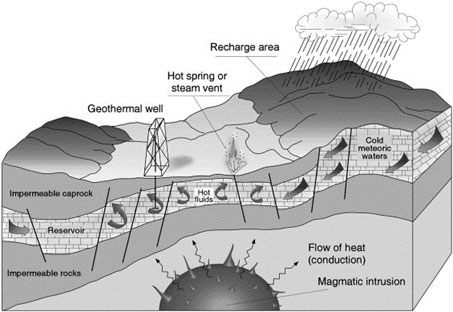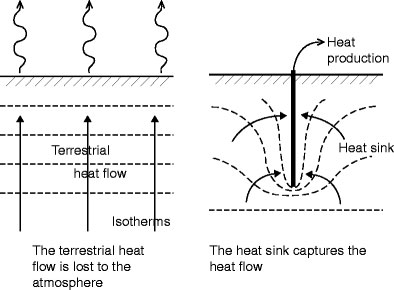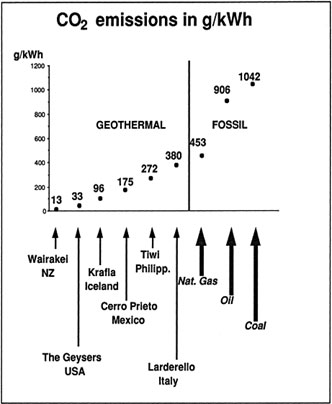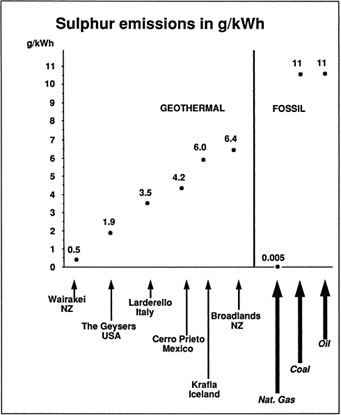Geology and Natural Heritage of the Long Valley Caldera
Geothermal Energy and its Applications in the Modern World
Will Kersey
Abstract
Geothermal energy, energy stored within the Earth as heat, is a topic which has garnered attention in the recent past because of its potential as a powerful energy resource. Though present technologies for geothermal energy capture are limited to regions with very specific geologic conditions, progress is being made towards technologies which could help to capture a greater portion of this energy resource without the necessity of such geologic conditions. Geothermal energy is often cited as being a ’green’ energy source with low environmental impact, and while the environmental impact differs from site to site, this generally holds true when compared to other energy resources. In this paper, geothermal energy, geologic conditions which concentrate this energy, methods of capturing geothermal energy, and uses of geothermal energy will be discussed.
Introduction
Geothermal energy refers to the energy stored as heat within the Earth. Earth’s internal energy is primarily sourced from the energy involved in its formation and the radioactive decay of certain isotopes within it [Barbier, 2002]. Together, these factors constitute the Earth’s ’heat budget’. Without human intervention, this heat is transferred directly to the atmosphere and from there to the surrounding gas of the solar system. The rate of geothermal energy production by radioactive decay is almost double the present rate of energy use by humans, indicating that this is a resource with potential which should not be ignored [Rybach, 2007]. The extraction and harnessing of geothermal energy for human use is a relatively young science with great future potential.
The Geothermal Resource
I. Geothermal Gradient
The Earth dissipates heat radially from its center. The average geothermal gradient of the Earth is approximately 30°C of temperature change per kilometer of depth [Barbier, 2002]. The geothermal gradient of the Earth is not constant throughout and can be drastically higher or lower than this average. The primary cause for areas with steeper-than-average geothermal gradients is surface-proximity bodies of cooling magma [Barbier, 2002]. Regions with geologically recent volcanism, for example, can have geothermal gradients as high as 200°C/km [Mock et al., 1997]. These magmatic bodies release large quantities of heat into the surrounding cool rock through conduction per the second law of thermodynamics. It is these regions of steep geothermal gradient which are particularly useful for the capturing and use of Earth’s heat energy as they represent areas with greater energy concentration.
II. Conditions and Processes which Concentrate Geothermal Energy
Bodies of magma or steep geothermal gradients near the surface are typically the result of tectonic activity along plate boundaries or mantle hot spots. Both divergent and convergent tectonic plate boundaries can create environments with steep geothermal gradients. Mantle hot spots such as those associated with Yellowstone and the Hawaiian island chain create volcanic activity at the surface as well. Iceland is an example of a region with both hot spot activity and a divergent plate boundary [Marshak, 2013].
Divergent plate boundaries occur when two tectonic plates are moving away from each other. This causes magma to upwell and generate new crust along the boundary [Marshak, 2013]. These boundaries are commonly associated with mid-ocean ridges, though some regions such as Iceland have divergent plate boundaries above sea-level where geothermal energy capture is feasible. This upwelled magma creates a steeper geothermal gradient because it is of a much higher temperature than typical rock at the same depth.
Convergent plate boundaries occur when two tectonic plates are moving towards each other. If at least one plate is oceanic, one of the plates will subduct beneath the other and plunge into the asthenosphere [Marshak, 2013]. In the case of convergence between and oceanic plate and a continental plate, the oceanic plate will subduct. In the case of convergence between two oceanic plates, one will subduct and the other will not. As the subducting plate plunges, the rock it is composed of will melt to form magma which will rise towards the surface as a magmatic intrusion [Marshak, 2013].
Figure 1. Magmatic intrusion and resulting hydrothermal activity [Barbier, 2002]
Figure 1 is an artistic representation of the effects of a magmatic intrusion in a typical and exploitable hydrothermal system. The body of magma dissipates heat into the environment through conduction. This heat can reach a fluid reservoir and heat the fluid within it. Fluid reservoirs require a permeable or porous rock and are most easily exploitable when held under pressure by impermeable rock [Barbier, 2002]. For the fluid reservoir to be sustained over time it requires a region where new fluid can enter it. This is represented in Figure 1 by an area where the permeable rock is exposed at the surface. As the fluids are heated by the magmatic intrusion, they will begin a process of convection. This helps to heat the entirety of the fluid body more quickly than by conduction alone, as the hot fluids will be displaced from the heat source bringing them into contact with colder fluids while simultaneously bringing colder fluids in contact with the heat source. These heated fluids will expand and can escape their reservoir through pathways provided by faults forming features like hot springs and geysers.
III. Hydrothermal Activity
Visible hydrothermal activity at the surface is a useful first sign of a possibly exploitable geothermal resource. This includes surface features like geysers, hot springs, and fumaroles, as these are indicative of both a volcanic heat source and the presence of a body of hydrothermal fluid, two important components for geothermal energy capture.
Types and Applications of Geothermal Resources
There are many different classifications of exploitable geothermal resources with different possible applications. The general method for extracting energy from a geothermal system is to pump a fluid which has been heated by hot rock to the surface and then to utilize the heat energy within that fluid. These can vary widely in chemical composition of hydrothermal fluid, amount of fluid present, geothermal gradient of the region, and many other factors. No two sites are exactly alike, but many share similar characteristics which are useful for classifying them. Among the most important of these are water dominated fields, steam dominated fields, and hot dry rock systems. Economic viability is a very important part of determining whether or not a geothermal resource is worth developing, and is generally measured by the comparative cost of production of a unit of energy against other sources.
I. Water Dominated Fields
Water dominated fields are defined by pressure within the fluid reservoir coming mostly from liquid water. These fields can exist at both high and low temperatures, though higher temperature fields require high pressure to maintain the liquid phase of the water [Barbier, 2002]. There are two primary types of water dominated fields; hot water fields and wet steam fields [Barbier, 2002]. The distinction between these two is that hot water fields have water in a liquid phase as a result of low temperature while wet steam fields have water in a liquid phase as a result of high pressure. Typically, the reservoirs of hot water fields will contain liquid water at all depths due to low temperature and geothermal gradient. Hot water fields are generally only considered economically viable if they are near the surface, have low salt content, and have high flow rates [Barbier, 2002]. Wet steam fields on the other hand can have temperatures far exceeding the boiling point of water while still containing liquid water due to intensely high pressure.
II. Steam Dominated Fields
Steam dominated fields are high temperature high pressure underground reservoirs of steam and other gases. Steam dominated fields are generally much higher in temperature than wet steam fields. Because of the pressure necessary to maintain this body of steam, an impermeable cap rock covering the reservoir is necessary to prevent rapid depressurization and loss of the fluid within the reservoir [Barbier, 2002]. When a well penetrates the steam reservoir it creates a depressurized area by connecting the high-pressure reservoir with the low-pressure surface, essentially using the pressure difference as a pump. This creates a pressure gradient surrounding the well which draws steam towards the well from within the reservoir. Use of these fields for geothermal energy extraction necessarily depletes the pressure of the reservoir which can take decades without energy production to recuperate [Rybach, 2007].
III. Hot Dry Rock
Hot dry rock systems are regions of rock without a usable amount of fluid within them for geothermal energy capture by typical methods. Frequently, the lack of a fluid reservoir is a result of the rock being impermeable. These systems present the largest source of potentially accessible geothermal energy as they are not limited to fault zones and can be found almost anywhere at sufficient depth. The cost of drilling geothermal wells increases exponentially with depth, however, meaning that these systems will not always be economically viable for energy production [Mock et al., 1997]. It is for this reason that hot dry rock systems with steep geothermal gradients are better suited for human use.
To exploit a hot dry rock system, hydraulic fracturing must be employed to create a connected system of fractures through which fluid can be pumped to extract heat from the rock. Essentially, this is the creation of an artificial fluid reservoir to be used to take advantage of the high temperatures found in underground rock. This is a much more expensive process than simply using a pre-existing fluid reservoir. The real strength of hot dry rock systems is that they do not require as specific of geologic conditions and are much more ubiquitous than traditional geothermal resources.
IV. High Temperature Applications
High temperature geothermal resources are typically used for the generation of electricity. This is accomplished through the use of heat and pressure differences between the reservoir and the surface to produce mechanical energy which is then used to turn turbines and generate electricity. Steam-based electricity generation is the most effective geothermal electricity generation method as steam dominated fields tend to contain the most energy per unit volume of fluid [Barbier, 2002]. Some relatively low temperature hot water geothermal resources can be used to generate electricity by transferring heat from the reservoir fluid to a fluid with a lower boiling point such as isobutene [Barbier, 2002]. These systems tend to be less efficient, but are less site-specific and can be developed in many more areas than steam-based systems.
V. Low Temperature Applications
A geothermal resource is considered low temperature if its temperature is less than 150°C [Mock et al., 1997]. Low temperature geothermal resources are typically used for direct heating in both industrial and non-industrial applications. This energy is used in industrial settings for increasing the efficiency of refining ore, dehydration of foods, drying of timber, and many other applications [Mock et al., 1997]. The use of geothermal heat pumps can warm houses in the winter, cool them in the summer, and provide hot water year round [Mock et al., 1997].
Sustainability
Geothermal resources are multifaceted and consist of several important components. Heat, pressure, and fluid volume are all necessary for energy extraction and are depleted during the production of geothermal energy. Each of these is naturally replenished at a different rate specific to a given location. For the use of a geothermal resource to be sustainable, the rate of depletion of each of these resources cannot exceed the rate of replenishment. Sustainable use of geothermal resources is not always economically viable which can lead to over-exploitation or ’mining’ of the resource.
I. Fluid Sustainability
Geothermal energy generation tends to extract much more groundwater than is replenished which can limit sustainability significantly [Barbier, 2002]. This can be offset through reinjection of hydrothermal fluid into the geothermal system, a common component of geothermal energy extraction. Reinjections wells are frequently used to offset depletion of the fluid body and possible environmental impacts from fluid waste. Reinjection can drastically increase the longevity of a geothermal resource. Frequently, more than 95% of extracted fluid is reinjected to prevent the loss of both the fluid body and pressure within the geothermal system [Barbier 2002]. In general, the sustainability of a body of hydrothermal fluid is heavily dependent upon the natural rate of regeneration. As seen in figure 1, the primary source of this regeneration is rainwater entering through exposed permeable rock. Reinjection reduces but does not remove the factor of fluid depletion, and for the resource to be sustainable, depletion cannot exceed the rate of recharge.
Figure 2. Heat depletion of geothermal resources by extraction [Rybach, 2007]
II. Heat and Pressure Sustainability
Geothermal energy capture depletes heat from the geothermal resource by creating a heat sink [Rybach, 2007]. Figure 2 graphically shows the difference between natural terrestrial heat flow and heat flow during extraction of geothermal energy. The lowest temperatures are found near the heat sink, and the overall temperature of the resource decreases with time assuming that its regeneration does not exceed the rate of extraction. On a theoretical basis, the resource will never return to its initial temperature following heat extraction as its regeneration follows an asymptotic curve [Rybach, 2007].
In classical geothermal resources with a pre-existing fluid reservoir, pressure within the reservoir is depleted during energy production. This can be offset by fluid reinjection, though this does not completely cancel the loss. Similar to heat, the pressure within a reservoir forms a gradient surrounding the well with the lowest pressure being closest to the well. In the same way as the heat, the total pressure within the reservoir will follow an asymptotic regeneration curve [Rybach, 2007].
Risks and Environmental Impact
I. Chemical Composition of Hydrothermal Fluids
The chemical composition of the hydrothermal fluids exploited in geothermal energy production is one of the primary sources of environmental concern surrounding geothermal energy. The fluids which are generally found in regions where geothermal energy is economically exploitable contain many dissolved minerals and gasses which can pollute the air and groundwater during energy production. Steam from wet steam or steam dominated fields can condense into water with very high salt concentrations which must be reinjected to prevent environmental pollution [Barbier, 2002]. In addition, the chemicals within hydrothermal fluids can precipitate within or corrode the piping used to transport them [Barbier, 2002].
Because hydrothermal fluids contain many gases, it is important to examine the factor of air pollution from geothermal energy capture. Among gases released in geothermal energy production are carbon dioxide and gases containing sulfur such as H2S [Barbier, 2002].
Figure 3 shows that geothermal energy capture methods produce less carbon dioxide per unit of energy than fossil fuels. The power plants at which these figures were recorded are all cost-competitive with fossil fuels as well, demonstrating that geothermal energy may be a viable and ’green’ source of energy for the future. Figure 4 shows that geothermal energy capture methods produce less atmospheric sulfur per unit of energy than traditional fossil fuels. Natural gas produces the least atmospheric sulfur by a wide margin. Nonetheless, this shows that geothermal energy has a smaller impact on atmospheric sulfur than traditional fossil fuel energy sources.
Figure 3. CO2 emissions of different geothermal fields and fossil fuel resources per unit of energy generated [Barbier, 2002]
Figure 4. Sulfur gas emissions of different geothermal fields and fossil fuel resources per unit of energy generated [Barbier, 2002]
II. Induced Seismicity
Hydraulic fracturing, fracturing of underground rock through the injection of fluid, is a technique that is employed in some instances of geothermal energy capture. It is used to create or expand underground fluid reservoir capacity and is particularly useful in hot dry rock systems where no initial reservoir is present. Geothermal energy capture and associated changes in underground fluid pressure have been shown to trigger earthquakes, though these are typically very small earthquakes termed ’microseismic events’ [Mock et al., 1997]. It is believed that these small earthquakes may relieve stress on tectonic plates in such a way as to reduce the likelihood of larger and more dangerous earthquakes [Mock et al., 1997] It is generally believed that seismic risks from geothermal energy capture are low [Mock et al., 1997].
Conclusion
Geothermal energy is a powerful natural resource with the potential to shape the future of human society. It is relatively clean and environmentally friendly when compared to present energy sources such as fossil fuels. Its possible applications are numerous and its ubiquitous nature means that it is not limited to any physical location for extraction or use, especially given that methods are being developed to access non-ideal systems such as hot dry rock systems. As the technology used to harness and extract geothermal energy becomes less cost-prohibitive and more regions are able to be developed for economically viable geothermal energy capture, geothermal energy has the potential to become a greater and more important contributor to global human energy use.
References
Rybach, L. (2007) Geothermal Sustainability Assessment Framework. GHC Bulletin: 1-7. Print.
Marshak, S. Essentials of Geology. 4th ed. New York, NY: Norton, 2013. Print.
Mock, J.E., Tester, J.W., and Wright, P.M. (1997) Geothermal Energy from the Earth: Its Potential Impact as an Environmentally Sustainable Resource. Annual Review of Energy and the Environment 305-356. Print.
Barbier, E. (2002) Geothermal energy technology and current status: An overview. Renewable and Sustainable Energy Reviews 3-65. Print.
[Return to Research Projects] [Return to Sierra Home]



